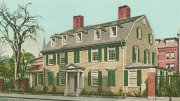1910
Thanks to the local construction company building the Cambridge portion of the new subway system, several thousand carts of earth are secured to fill in the lower part of Soldiers Field, which will be used as playing fields by Harvard teams.
1920
The Business School adds regular instruction in labor relations to its curriculum.
1930
A carillon of 21 Russian church bells, weighing 27 tons, has arrived in Cambridge to be installed in the Lowell House tower as a gift from an anonymous donor.
1940
Concern over Nazi victories in Europe prompts the creation of a 400-member Faculty Defense Group, the Harvard Student Defense League organizes military-drill practices, and more than 130 undergraduates apply for a pilot-training course. Harvard announces that students enlisting in the armed forces or drafted are liable only for the portion of tuition and fees incurred prior to their departure.
1955
Harvard College welcomes its first Advanced Placement freshmen, and the Divinity School registers its first women graduate students.
1960
Leverett Towers and the Loeb Drama Center open for business.
1985
The newly created Harvard-Radcliffe Grocery Society, or “Grocery Table,” organizes petitions for the return of Classic Coke in House dining halls. The group’s charter mandates that members “promote student awareness of an appreciation for the grocery sciences, especially produce, dairy products, and other foodstuffs” and guide their actions by the official motto: Vivere Melius Per Condimenta (“Better Living Through Groceries”).
1995
Boylston professor of rhetoric and oratory Seamus Heaney, “a frizzy-haired man of great amiability, for whom many at Harvard feel warm affection,” wins the Nobel Prize in Literature “for works of lyrical beauty and ethical depth, which exalt everyday miracles and the living past.”









